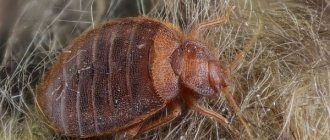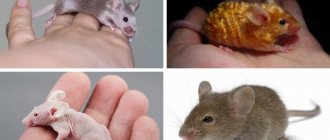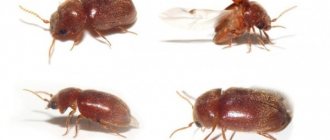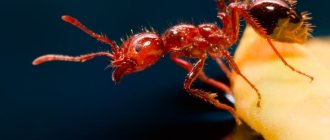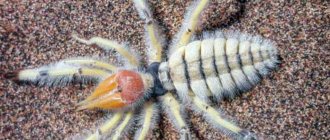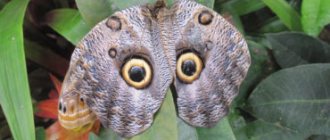Origin of the species and description
Photo: Admiral Butterfly
Lepidopterists, people who devote their lives to butterflies, often give them names associated with mythology. Our beauty received her Latin name atalanta, inheriting it from the daughter of the king of Arcadia, whom her parents, expecting the birth of her son, threw into the forest, where she was nursed by a bear.
Admirals belong to the Vanessa family. What it has in common with other representatives of the nymphalid family is the presence of brushes on the shortened front legs; there are no claws on them, and the veins on the wings do not have thickenings. These insects are called lepidoptera because their wings are covered with scales modified by hairs of different shapes. They are placed along the wing in rows, like tiles, with the base directed towards the body, the free edge towards the end of the wings. The scales contain pigment grains responsible for coloring.
Video: Butterfly Admiral
Some scales, called androconia, are associated with glands that secrete an odorous secretion. This is how males attract their partners by smell. Like all representatives of the detachment, admirals appeared relatively recently, from the Tertiary period. The fore wings of these vanes are larger than the hind wings, interlocking with each other using a chitinous frenulum. Like all nymphalids, when open, the wings of the admiral are brightly colored; when folded, the lower part of the surface is camouflaged.
Interesting fact: When folded, the large front wings remain inside, and from behind the rear wings only the very top corner is visible.
Do you know what a mourning butterfly looks like?
The most spectacular and largest representative of the Nymphalidae family of the order Lepidoptera is the mourning butterfly. This flyer, widely distributed throughout Eurasia, with the exception of the tropics, is absent only in the territory of Mediterranean states, but at the same time, some individuals fly into tundra territories. Once brought to America, the mourning plant has spread from Canada to Mexico. For unknown reasons, in the forties of the 20th century, the number of individuals of mourning birds decreased sharply. In this regard, in 1997 it was included in the Red Book of the Smolensk Region in the 3rd category, which includes species distributed in limited areas that are at risk of extinction if natural or anthropogenic conditions change.
Appearance
The mourning butterfly is a butterfly that gets its name due to its color. Its colors are so memorable that it leaves a huge impression for many years. The most accurate description of what the mourning butterfly looks like was described by S.T. Aksakov. Shiny, covered with a large amount of colored pollen, velvety dark brown, coffee, and at a certain angle, dark purple wings are trimmed with a white or yellow jagged border, along which there are bright blue spots. The wingspan of the butterfly reaches 7-10 cm. Like all nymphalids, the mouth of butterflies is a proboscis, which curls into a spiral and unfolds when the butterfly feeds. Its front legs are short and lack claws.
origin of name
Carl Linnaeus, knowing what the mourning butterfly looks like, gave it the name antiopa in 1758, in honor of the heroine of Euripides' tragedy, which tells about the suffering and troubles that befell Antiope, the daughter of the Theban king Nikteus, seduced by Zeus, who appeared in the form of a satyr, and gave birth to him two twins married to Epopey.
While studying mourning birds, scientists paid attention to the influence of external temperatures prevailing during the development of the pupa on the subsequent intensity of the color of the insect’s wings. Depending on the climatic conditions of its habitat, there are differences in how the mourning butterfly looks - the color of the wing darkens, the size of the blue spots decreases, the density of the black coating on the border changes
Thus, overwintered butterflies that fly out of their wintering grounds at the beginning of spring have an almost white border. However, this does not apply to butterflies that wintered in the East - they have a yellow border. In July-September, the new generation of mourners, whose pupae developed in the warm season, have a bright yellow border.
Development
In June, the female lays up to 100 eggs. The caterpillars hatch in June-July and stay in dense groups until the pupation period. What a mourning butterfly looks like when it is in the caterpillar stage is familiar to many. Black with white small dots and bright red spots (up to 7 pieces) between the thorns, the caterpillars often crawl along the leaves of birch, alder, maple, ash and other plants that serve as their food. The pupal stage of development is about 11 days. The butterfly feeds mainly on tree sap, so it can often be found on birch trees during the period of intense sap formation.
Appearance and features
Photo: Butterfly of Russia Admiral
The front wing has a size of 26-34.5 mm, with a span of 50-65 mm. The upper surface is black, velvety brown.
Characteristic coloration of the front wings:
- there is a small tooth on the outer side of the ending;
- at the top a row of white spots runs parallel to the outer edge;
- a little closer to the head there is one wide, elongated spot;
- A curved carmine-red wide stripe runs diagonally.
Hind wing color:
- a carmine-red wide border runs along the lower edge;
- each of the five segments of the bright stripe has a black dot;
- in the extreme lower corner there is a double blue spot with a black outline.
A wavy, thin white stripe borders all four wings. The lower surface is paler in coloring, but very pockmarked. The front wings are ornamentally similar to the upper surface, but they are not so bright, complemented by bluish areas almost in the center of the upper edge. Coloring of the lower surface of the rear wings:
- the tobacco-gray background is dotted with black, dark-brown lines, small circles, and grayish stains;
- a larger whitish spot is located in the very center of the upper edge.
The back of the body is dark, black or brown, the abdomen is lighter brown or tobacco color. The chest is divided into three parts, each of which contains a pair of limbs. The role of the oral apparatus is performed by the proboscis. The butterfly's compound eyes are covered with bristles and have a crystalline structure. The antennae are club-shaped thickened in the upper part; they act as one of the sense organs. with their help, nymphalids can detect the slightest vibrations in the air and sense aromas.
Migration is linked to nutrition
The range of the admiral's butterfly is only slightly smaller than that of the burdock, and within this range it is found in many habitats - suburbs, parks, gardens, wooded edges and paths, around wetlands, floodplains, wet fields and ditches - anywhere it may be close to various species of nettle, which are food plants for its caterpillar.
Most sources limit the caterpillars to nettles, but some add milk thistle, willow, and/or members of the plant family Cannabaceae (yes, that's a plant family), a family that mainly consists of curry and hops. It is believed that adults do not nest on flowers, but live on tree trunks.
In the afternoon, males are said to defend territories with semi-light-edged clearings and search for females to whom they are attracted. The question is whether the males actually defend a territory or simply chase around until they determine their species and sex by taking to the air several times. Some butterflies fly in a spiral upward to the treetops. Females fly slowly and purposefully in search of plants to lay eggs on. Butterflies scratch the surface of the leaf with their bristly legs and then taste it. If the admiral butterfly recognizes the plant, it will lay an egg on the upper surface of the host plant's leaf. The hatched caterpillar folds the leaf around itself and takes refuge inside.
Where does the admiral butterfly live?
Photo: Admiral Butterfly in Russia
The geographic range of distribution of Vanessa atlanta extends in the Northern Hemisphere from the north of Canada to Guatemala - in the west, from Scandinavia to the European part of Russia, further south to Africa, its northern part, and eastern China. It can be seen in the Atlantic on Bermuda, Azores, Canary Islands, in the Pacific Ocean on Hawaii, and other Caribbean islands. The insect was introduced to New Zealand and breeds there.
Nymphalidae cannot survive cold winters, but during migrations it can be found from the tundra to the subtropics. Unable to endure extreme frosts, the fluttering beauties migrate to the southern regions, to warmer places. This representative of Vanessa loves damp forests, marshy areas, water meadows, and gardens with regular irrigation. This is one of the last butterflies that can be found in northern Europe before the onset of winter. In mountain ranges it can live at altitudes of up to 2700 meters.
Lifestyle
A description of the admiral butterfly will be incomplete without talking about the features of its lifestyle. The insect is a heat-loving species and spends the winter only in the southern regions. During migration, moths rise to a considerable height, where they are picked up by the wind and carried in the desired direction. This saves the insects' energy. The summer begins in May-June and continues until the end of September. One, sometimes two generations are replaced per year. The second generation has a darker color of the wings. The English name of the insect RedAdmiral (red admiral) accurately characterizes the unique coloring of the butterfly. The mobile species can be found in any unexpected places - on the river bank, in a city park, on a farm. Admirals are active on sunny days in clear weather. On rainy and windy days they hide in a shelter.
Information. Vanessaatlanta often rest on the trunks of oak or larch trees. Butterflies put their wings behind their backs and completely merge with the bark of trees. Their camouflage coloring hides them from predators.
Lepidoptera are insects with complete metamorphosis. They go through all stages of development: egg, larva (caterpillar), pupa, imago. How long does the admiral butterfly live? In favorable conditions, it is long-lived - the insect lives 9-10 months. For part of the allotted period, it remains in hibernation; it is the presence of diapause that explains its long existence. The fertilized female overwinters in order to immediately lay eggs the next year after waking up. In the North and Center of Europe, admirals do not stay during the cold period. They go on a seasonal migration south. It is less noticeable than in summer, when a large number of adults settle in gardens and parks rich in food.
Migrants that appear in the summer produce offspring on local plants. Young butterflies fly in July-August. They are not shy; if handled carefully, they can land on clothing or a hand. It is easy to distinguish between visiting and local admirals by the condition of their wings - travelers’ wings are tattered and faded. During the wintering period, moths look for a reliable shelter where they can hide not only from the cold, but also from enemies. Females hide under the bark of trees, fallen leaves, and hide in crevices. While sleeping, they run the risk of being eaten by birds or rodents.
General climate warming and mild winters have led to changes in the behavior of the admiral butterfly. Not all individuals go to wait out the cold season in hot Africa. Some remain in temperate latitudes. This decision is completely justified, because many insects die while covering distances of thousands of kilometers.
Nutritional Features
What does the admiral butterfly eat? Adults prefer to drink nectar from asteraceous plants:
- cornflower;
- thistle;
- ivy;
- blackberry;
- scabious;
- Asteraceae
At the end of summer, moths have the opportunity to expand their diet with overripe sweet fruits. They drink the juice of bursting peaches, plums, and pears.
Interesting fact. Admirals prefer rotten and fermented fruits.
What does the admiral butterfly eat?
Photo: Admiral Butterfly
Adults feed on fruits; they can be seen on carrion; they love the fermented juice of overripe fruits. Sugary liquid secretions from trees and bird droppings also serve as food. At the end of summer, Vanessas sit on overripe fruits. Among flowers, if there is no other food, they prefer aster, spurge, alfalfa, and red clover.
Caterpillars eat leaves of stinging nettle, stinging nettle, and other plants from the Urticaceae family. They live on hops, plants of the thistle genus. The oral apparatus of an adult is unique. The soft proboscis, like a steel watch spring, can open and curl. It is mobile, elastic and adapted to absorb liquid nectars and plant juices.
Interesting fact: On the front legs of an insect there are sensitive villi, which are equipped with taste buds; the admiral takes the first “sample” by sitting on a fruit or tree sap.
Butterfly nutrition and protection of feeding territory
In early spring, nectar awaits red admirals on yellowish birch catkins and blackthorn and hawthorn flowers. Favorite sources of summer nectar include dogwood, agrimonia, blackberry, marjoram, thistle, burdock, burdock, and ivy.
They also visit dung or absorb mineral salts from moist soil and visit drops of sap on oak trunks. In orchards they will eat fallen apples or pears.
Admirals are one of the most intelligent species of butterflies - they have the ability to get used to, that is, learn to react less strongly to stimuli that turn out to be harmless. Upon entering their territory, the intruder is immediately investigated.
admiral butterfly on a leaf
In the event of a human invasion, the admiral butterfly will circle several times and try to find out if the person is a threat. If he or she seems harmless, the butterfly becomes increasingly brave - the butterfly gets used to the presence of a person and again the butterfly behaves as if no one is there.
admiral butterfly food
On the other hand, if the intruder reacts to the butterfly by chasing it, it becomes wary, and further pursuit will be enough to drive the butterfly out of the area for a few minutes.
Features of character and lifestyle
Photo: Admiral Butterfly from Russia
The winged insect has fast and erratic flight, speeds can reach 15 km/h. When migrating, the admiral moves over vast distances, and in order not to lose a lot of energy, he rises high into the sky and flies using air currents. Such flights can be significant: from one continent to another.
During the winter months, depending on the habitat, the butterfly falls asleep until spring, appearing with a brighter coloring, but they can be seen fluttering on sunny winter days in the southern regions.
Interesting fact: Vanessa Atlanta needs brightly colored wings so that individuals of this species can recognize each other from a distance. Up close, they are recognized by the smell emitted by androconia.
When some insects, hiding in the crevices of the bark or leaves, fall asleep, others set off on their way to warmer climes and spend the winter there. For winter periods, European individuals choose the north of Africa, and North American individuals choose the Atlantic islands. Specimens that remain for the winter do not always survive until spring, however, like those that make long, dangerous migrations. Flight periods may vary depending on the habitat: from early May-June to September-October.
Interesting fact: These nymphalids have color vision, seeing yellow, green, blue and indigo. Since admirals do not have lateral filter pigments, they cannot see shades of the orange-red spectrum.
Security
In Russia, the admiral butterfly was rarely seen - the population size has seriously decreased due to the treatment of fields with chemicals. The Red Book has contained information about it since 1997, but then the species was excluded from the publication. The situation remains difficult only in the Smolensk region. In this area, the population has a declining status.
In 2021, the number of admirals has increased significantly in the European part of the country. Scientists say that similar rapid rises and falls in numbers occur in most insects. Why is that? There are many factors that are difficult to predict. Scientists identify the following two most popular factors, explaining the natural phenomenon briefly:
- If there are frosts at the beginning of summer, fewer individuals are born.
- Parasitoid insects use caterpillars to feed their own offspring. When the number of such pests decreases, the number of butterflies increases.
The life of butterflies is negatively affected by deforestation, plowing of meadows and the use of chemicals to treat plantings. In Russia, admirals are most often found in meadows, along roads, near forests, and also in mountainous areas. Butterflies live in the Urals and the Eastern Caucasus, Karelia and the central part of the country. In recent years, insects with colorful wings have become frequent guests on the shores of the White Sea. Local residents say that this is a real invasion.
The butterfly chooses its habitat for a reason. The number of generations depends on it - there can be from one to three offspring per year.
The climatic conditions of most regions of Russia are not suitable for fastidious insects. The Admiral is one of the few exceptions. A brightly colored butterfly, similar to the bud of an exotic flower, pleases the eye from spring to autumn. The fragile insect does not harm cultivated plants. Therefore, do not rush to get rid of the furry caterpillars if you suddenly see them in the garden or beds, because soon it will turn into a colorful butterfly with an unusual sea name. Read more about the benefits butterflies can bring.
On the front wings there are white spots in the corners, which are separated by a bright red stripe. The same stripe runs along the edge of the lower wing. These stripes gave the butterfly its name: in the old days, admirals had red stripes on their trousers, and they wore red ribbons over their shoulders.
The Admiral's caterpillar is brown-red, with yellow stripes, spines and dots. They live on the leaves of nettles and thistles. The Admiral butterfly is found on forest edges, clearings, meadows, on sunny river banks, and along roadsides. Flight time is from May to October.
Social structure and reproduction
Photo: Butterfly Admiral Russia
Admirals are creatures with complete transformation, going through all stages from egg to larva, which turns into a pupa, and then regenerates into an adult. Before mating, males persistently court their chosen ones, while simultaneously repelling the attacks of rivals. They fly around their territory up to 30 times per hour. During this time, they manage to interact with other applicants 10-15 times, and this activity continues throughout the day.
The area of the plot, which has the shape of an oval, occupies 2.5-7 m in width and 4-13 m in length. When an intruder appears, the male drives him away, rising in a vertical spiral to tire out the enemy. After expelling the enemy, the owner of the site returns to his territory and continues to patrol it. Only the hardiest individuals are able to win a female in order to leave offspring. Males often sit in bright, sunlit areas and wait for the females to fly up.
Interesting fact: Depending on their habitat, admirals can have one, two or three generations of offspring per year.
A green, oval, ribbed egg (about 0.8 mm) is laid by females on the top of a leaf of a food plant. A week later, when emerging, the size of the greenish larva is 1.8 mm. As it grows and molts (5 stages of development in total), the body length changes to 2.5-3 cm, and the color also changes. It may vary slightly, but most often it is black with white dots around the body.
The caterpillars have spines with reddish bases; they are arranged in a ring-like pattern in segments. There are seven rows of spines along the body. A stripe of white or cream spots runs along the sides of the body. The caterpillars' diet is leaves, most often from the nettle family. They hide from enemies in leaf plates folded in half.
Interesting fact: When growing larvae in different laboratory conditions, at temperatures around 32°, the pupal stage period lasted 6 days. At 11-18° this time extended and amounted to 47-82 days. In warm conditions, the pupae and butterflies that emerged from them were brighter.
At the end of the last stage, the caterpillar stops feeding. When building a house for the next stage of life, she eats the base of the leaf, but leaves the veins, folds it in half and glues the edges. The shelter hangs freely on the veins, in it a nondescript, gray pupa with short spines and golden spots is located upside down. Its size is about 2.2 cm.
Habitat
It has a wide habitat - Eurasia, the North American continent, the islands of the Northern Hemisphere, northern Africa. Avoids tropical climates, but can be found in the mountains (no higher than 2.6 thousand km). Like all butterflies, the Admiral feeds on nectar, so it can be found everywhere: in the clearings and lawns of a forest or park, in gardens.
In the northern parts of their range they appear in May-June and can remain there until October. They prefer to lay eggs on nettles, hops and thistles, which then serve as food for the caterpillars. The caterpillars turn into pupae with golden specks in time, from which a new butterfly then emerges.
These butterflies gather in flocks and fly over the mountains and the Mediterranean Sea. During autumn cold weather, they migrate to the warm southern part (Africa), where they lay eggs and die. The same new generation again migrates to the northern regions during the warm period. But some specimens remain to spend the winter in cold places. They wait out the winter under the bark of trees, in crevices, hibernating. And in the spring, when it gets warmer, they fly out again.
Natural enemies of admiral butterflies
Photo: Admiral Butterfly
Thanks to their uneven, rapid fluttering, these winged creatures are difficult to catch, since it is impossible to predict where they will direct their flight next. Bright admirals are very trusting and can sit on an outstretched hand. When the wings are folded, it is difficult to notice them against the background of the tree bark where they hide to sleep. They become more available when they drink nectar or become slower before hibernation.
Birds are the main enemies of adults, although some are scared off by their bright colors. Among those who can still hunt flying butterflies are bats. The shaggy appearance of the larvae scares away many who want to feast on them. Of all the birds, perhaps only cuckoos risk diversifying their diet with caterpillars. Rodents also include these lepidopterans in their menu, regardless of their developmental stage. Amphibians and reptiles of various species prey on Vanessa atlanta and its larvae. Caterpillars have their own enemies among insects.
They can be eaten by representatives of:
- Coleoptera;
- spiders;
- dragonflies;
- os;
- praying mantis;
- ants.
Growing butterflies at home
Growing admiral butterflies is not prohibited by law. At the first stage you need to collect the caterpillars. In order for the brown butterfly to fully develop, use the food supply of your region. It is recommended to collect the leaves of the plant on which you found the caterpillars.
A container with a ventilated lid is required for storage. The bottom of the container is filled 2 cm with soil and leaves. The optimal temperature for the insect is 20-25 °C. Maintain cleanliness by removing excrement and mold.
The emerging pupa is kept in the open air. Ventilation and humidity are important for its development. After 9-14 days, a butterfly will emerge from the cocoon.
Butterfly admiral
Story
A rich palette of colors and intricate patterns on the wings distinguish butterflies from other insects. It is no wonder that these sublime creatures are given the names of heroes of ancient myths. The admiral butterfly is named after Vanessa Atalanta (from the Latin: vanessa atalanta). Carl Linnaeus chose for the new species the name of the daughter of the hero Scheneus, who dreamed of a son. In Ancient Greece, it was believed that an upset father got rid of Vanessa by throwing her off a mountain. A beautiful girl spent her life in the forest. See what types of butterflies exist.
There are two known versions of the origin of the name Admiral. According to the first, the name comes from a Turkish word that translates as “lord of the seas.” Although the butterfly prefers to live in meadows, it easily goes on long journeys and flies across bodies of water.
The second version is marine - the insect was so called because of its color. Red stripes on a dark background are reminiscent of admiral's ribbons - the kind that fleet commanders had.
In crossword puzzles there is a question about the naval butterfly. If you see him, try using the word “admiral.”
How to care for butterflies at home?
If you decide to keep an Admiral butterfly at home, it is important to understand that this beauty lives for about ten months. For this purpose, you can look for and take a caterpillar or pupa of this species directly from the street. In order not to damage the insect and to know what plants it feeds on, it is better to take the caterpillar directly with the leaf. It is better not to handle it with your hands to avoid causing harm and infection. It is worth looking among its favorite food (for example, among nettles). Remember that caterpillars of this species like to wrap themselves in plant leaves.
First of all, you need to prepare a transparent plastic or glass container. You can use a glass aquarium. It should contain plants as food, soil and twigs from trees on which the caterpillars will crawl and then turn into pupae. Nettles, common hops, and types of thistles are perfect for feeding future Admiral butterflies.
Such a container is covered on top with a fine mesh or gauze to allow air to enter. Leaves for nutrition need to be changed every day. They can be washed and sprinkled with water - this will be another source of water for the caterpillar. Leaves can be placed in tubes with water for flowers, but vases and jars are not suitable for this purpose - caterpillars can drown in them if they accidentally fall.
Also, to maintain humidity, such a container must be moistened by spraying it with a spray bottle. For comfort, the bottom of such a container is covered with a paper towel or napkins.
After a certain period, the caterpillar transforms into a pupa. At this time, the caterpillar becomes less active and changes its color, and does not eat well. The pupation process lasts approximately two to three days. It is advisable to set the temperature at +26… +29 °C, humidity – about 90%. It is necessary to constantly spray the container during this period for better development.
The pupa should be placed so that it can easily spread its wings in the future. To do this, if necessary, you can move a twig or leaf to a more suitable place in the container.
After the pupa becomes a butterfly, the question becomes relevant: what do butterflies eat at home, including in winter? Admirals, like all other species, eat nectar from flowers. To prepare it at home, you need to mix sugar or honey with water in a ratio of 1:10. You can also add juicy fruits (pears, plums, oranges). It is better to take the middle of the fruit, because the peel can be treated with chemicals. Nectar and fruits are placed in a saucer for convenience. They are fed once or twice a day.
The temperature should be in the range from +24 to +30 °C. If the room is dry, then you need to spray the butterfly with a spray bottle, keeping a distance of about 30 cm. During sleep, this winged creature is moved to a box with a moistened cloth or foam rubber; you can use a special entomological envelope. It is necessary to follow certain safety rules in order to properly care for a butterfly at home, as it is a very fragile creature.
Namely:
- do not take it by the wings with your hands, so as not to damage them;
- make sure that windows and doors to the street are closed if it is outside the container;
- It is better to keep it at a distance from the source of light and heat; these creatures should be kept out of the reach of small children and pets (especially if there is a cat or dog in the house);
- you can’t catch them with your hands, it’s better to wait until she sits down and then carefully grab her by the body with your fingers;
- Make sure that the butterflies in the container (aquarium) do not fly, as due to the small size of the container they can hit the walls and lose their attractiveness.

